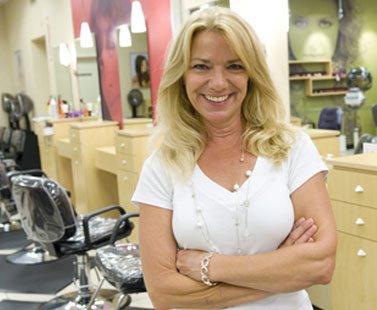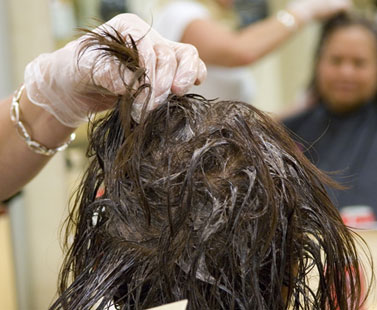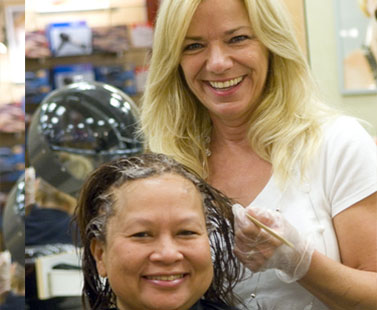Hairdresser on Double-Duty

Unexpected Ally in the Fight Against Skin Cancer
Over the scalp she goes – running her fingers, parting the hair, scanning it inch by inch. When you sit in the chair of this hairdresser, you’re getting more than a haircut!
Thrisha Rom scans the scalps of her clients looking for possible signs of cancer. She’s a hairdresser on double-duty – creating fabulous hairstyles and doing her part to save clients from the ravages of skin cancer.
“You can’t check your own scalp the way someone else can who’s standing over you”, says the 53 year old hairdresser from Land o’ Lakes. “Because we (hairdressers) have that physical contact with people, we’re more aware of the things that may show up. With a client that’s been in your chair a couple of times you notice things that may not have been there before.”
Rom has been a hairdresser for 35 years. She started taking a more “clinical” approach to clients’ heads 20 years ago. Becoming a mom was the turning point in her life – inspiring her to start looking for ways to “help people stay healthy”. Her choice: battling cancer from the salon chair.
“When I’m working with a client, I’m trying to get a ‘vision’ of where they want to go with their hair. Then, I look at the hair to see what I can actually do”, explains Rom. “I’m going through their hair with the comb to see what might get in the way, like a scar or a cowlick. As I’m doing that, it’s easy to see the scalp. If I see something that’s a red flag, I let them know.”
Rom is the first to admit she’s “no doctor”. When she spots a lesion on the scalp, a worrisome spot, discoloration, or “something raised” Rom recommends a trip to the dermatologist. On the day we visited with her, Rom was hard at work at the JC Penny Salon in Wesley Chapel explaining to clients what she was doing as she ran her fingers through their hair. She’s always done that, she says, in every salon she’s worked in – from Maryland to Florida. She’s proud of the fact she’s never had a single client pass up on the chance to have their scalp checked. Asked if anyone ever came back with a life-threatening diagnosis, Rom says with relief, “I’ve been very lucky. Most people come back with a good report.”

“I laud her for what she’s doing!” says Dr. Neil Alan Fenske, Chairman of the Department of Dermatology & Cutaneous Surgery at the University of South Florida, College of Medicine. “I encourage ALL hairdressers to do this. It’s a noble thing. I actually tell my patients, ‘have your hairdresser examine your head when your hair is wet.’ That’s when they can actually see the spots.”
While Dr. Fenske points out that most skin cancers on the scalp are not discovered by hairdressers, he encourages professionals in that industry to follow in Rom’s footsteps. “It would be a great service to their clients and to the community at large. I don’t expect them to make a diagnosis. That’s not their training, but if they can simply point out any lumps, bumps or sores, that individual can bring it to the attention of their dermatologist. That would be mission accomplished!”
In an ironic twist of fate, two years ago it was a client in the hairdresser’s chair who spotted the first signs of cancer on Rom. The client urged Rom to go to the doctor to have the small bump on her eye checked. When Rom did, doctors found Basal Cell Carcinoma.
“Here I was thinking it was a blocked duct. It almost looked like a pimple”, she recalls. “When you see the pictures and read the description of skin cancer lesions, this one just didn’t fit! I dug at it one time and it started bleeding. I had my 80 year old client in the chair one day, and she’s had things (skin cancer cells) taken off her face before, and she said I needed to go.” Looking back, the veteran hairdresser admits she was uneasy being on the other side of the equation. “I was scared. I was thinking, ‘oh God, how far is this going to go?’”.
Rom put her skin in the hands of specialists at the USF Clinic’s Dept. of Dermatology & Cutaneous Surgery. She’s now living cancer free. The team is lead by Dr. Fenske, a thirty year veteran in dermatology and a specialist in skin cancer. More than 21,700 patients were treated last year by USF’s experts in dermatology. Of those patients, 5,105 were new.
“Skin cancer on the scalp is uncommon when a patient has a full head of hair, but it still occurs”, says Dr. Fenske. “When it does happen, it’s likely Basal Cell Carcinoma and, in rare cases, Melanoma.” With patients who are bald or have thinning hair, Dr. Fenske says Squamos Cell Carcinoma is more common. The latter form of cancer is most clearly linked to day to day sun exposure. “Basal Cell Carcinomas are caused by sun exposure, yes, but we know other factors play a role. Scientists just don’t know what they all are”, says Dr. Fenske.



According to the American Academy of Dermatology, more than 1 million new cases of skin cancer will be diagnosed in the U.S. in 2007. The statistics become incredibly personal when you consider the data that indicates 1 in 5 Americans will develop some form of skin cancer in their lifetime. Melanoma is the second most common form of skin cancer attacking women ages 20 – 29 and the most deadly among older Caucasian men.
The top four warning signs are: asymmetry (one half is unlike the other), irregular border (scalloped or poorly circumscribed borders), color variation (especially red, white & blue) and a diameter greater than a pencil eraser (approximately 6mm).
While the danger signs are most often found on the skin, some skin cancers can develop in areas not even exposed to sunlight. In a recent article for the Journal of the American Academy of Dermatology, Dr. Fenske wrote about mucosal melanomas found inside the mouth, the female genital tract, anal/rectal tract, and urinary tract sites. With that in mind, its no wonder that specialists balk at the notion that a full head of hair means no chance of cancer.
In the face of such uncertainty, a total body skin examination remains the best preventive medicine – one that includes the often-ignored scalp and even the soles of the feet.

Hairdresser Thrisha Rom with long-time client Lisa Schaefermeyer, a former adjunct professor in the USF Dept. of Psychiatry. Clients have come to expect the “extra” attention Rom gives to keep customers healthy.
Story by Lissette Campos, USF Health Communications
Photography by Eric Younghans, USF Health Media Center

